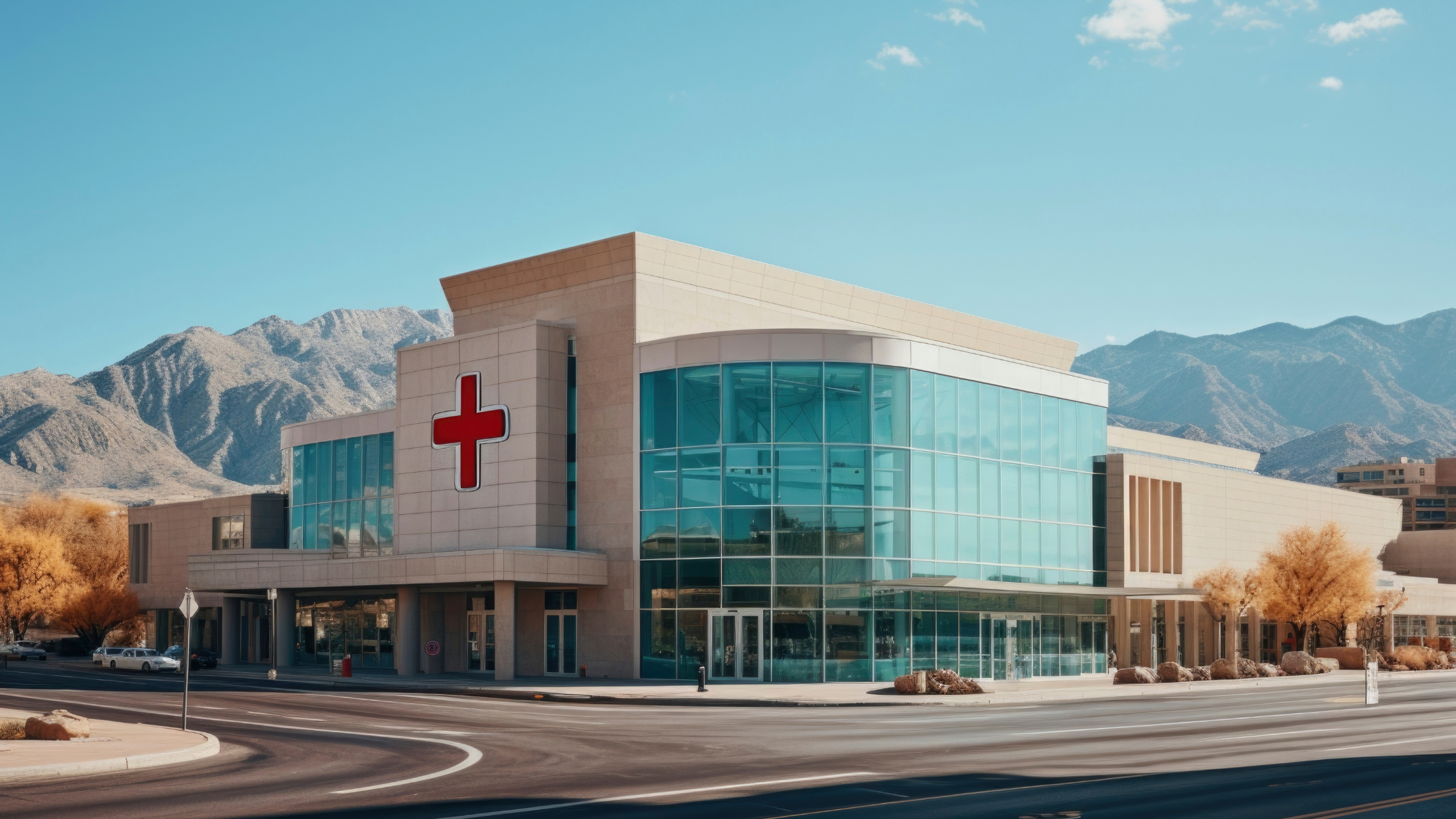Key takeaway: Demand for healthcare CRE — particularly Medical Outpatient Buildings or MOBs — should be strong in 2025 due to a combination of four reasons: an aging population, rising healthcare costs, technological advancements, and a balanced supply/demand dynamic.
According to the latest CBRE analysis, evolving consumer preferences for accessible healthcare and improving capital markets activity will make MOBs solid bets for CRE investors. Off-campus MOB development is notably increasing, but on-campus development remains high due to physician preferences. In 2025 outlook, MOB leasing and sales should take off even further if inflation eases and potential interest rate cuts materialize.
Healthcare has been one of the most active CRE segments lately, and we are in end month of 2025, you might be wondering if now is the right time to jump in.
Healthcare systems have been responsible for about 31% of all leasing activity by healthcare-related businesses since 2019, so this segment certainly has potential. But, as with any CRE investment, timing is key.
Some fascinating medical trends have emerged. For example, large transactions for dedicated administrative space — which accounted for over 2.2 million sq. ft. or 67% of all space leased by healthcare systems back in 2019 — have dropped considerably, averaging only 700,000 sq. ft. per year between 2020 and 2023.
On the flip side, the space leased for patient services has actually increased, going from 1.1 million sq. ft. in 2019 to an average of 1.2 million sq. ft. annually between 2020 and 2023.
This shift may be signaling opportunities. While healthcare systems are consolidating and downsizing their administrative footprint, the push for accessible healthcare — primarily through hospital-affiliated urgent care clinics, surgery centers, and medical outpatient facilities — is fueling demand for Medical Office Buildings or MOBs.
A lot of this demand is coming from major systems establishing medical outpatient facilities in the suburbs to bring healthcare closer to patients. These smaller, specialized outpatient facilities offer convenience and cost savings for both patients and medical staff.
Major medical providers are also leasing space in a variety of property types — purpose-built MOBs, traditional office buildings, and even former anchor-tenant spaces in shopping malls — to improve patient access.
Also Read About:: How to Use CRE Loans for Medical Buildings?
Why healthcare real estate might be the next big CRE investment
CBRE’s analysis indicates that several factors are converging to drive interest in healthcare CRE.
One of the biggest is the aging US population. By 2030, all baby boomers will be retired — meaning seniors will make up 20% of the population, up from 17% in 2024.
This should increase spending on outpatient healthcare, which is projected to grow by 31% to almost $2 trillion over the next ten years.
It’s worth noting that although seniors are only 17% of the population, they account for a substantial 37% of all healthcare spending.
Economic improvements and lower inflation by the end of 2025 should also help support continued consumer spending on healthcare. Even when adjusted for inflation, spending on healthcare goods and services is expected to grow by 2.5% in 2025 — faster than general consumer spending for the fourth year in a row.
The healthcare job market is also expected to remain strong. A recession remains unlikely; in fact, unemployment is predicted to rise only slightly to 4.4% by the end of 2025, which is still below the ten-year average.
Healthcare employment (particularly in outpatient services and specialized medical practices) continues to grow much faster than overall US job growth.
The trend of providing outpatient and behavioral health services in CRE properties has further boosted demand for healthcare workers, with employment in MOBs jumping by 13% between 2019 and 2024.
What’s more, outpatient care is becoming increasingly popular because advances in technology mean more and more procedures can be done outside of hospitals (in places like surgical centers and doctor’s offices).
The Centers for Medicare & Medicaid Services has even expanded the list of procedures covered in outpatient surgical centers, and this trend is likely to continue as technology gets even better.
Patients prefer outpatient care because it’s often much cheaper, too. For example, a gallbladder surgery that could cost $12,000 in a hospital might be only $2,200 in a surgical center. This is why insurance companies are increasingly encouraging patients to choose outpatient facilities.
Finally, patients like the convenience of getting care closer to home. Data from the American Hospital Association shows a big jump in the use of outpatient facilities, with patient visits per person increasing significantly since 2000. As these facilities expand and improve, we can expect outpatient services to keep growing.
Also Read About: How to Find Investors for Commercial Real Estate?
Leasing activity in MOBs
Even though we’ve seen a lot of new MOBs built over the last ten years, demand is still outpacing supply — and CBRE expects it to grow further. Their analysts are forecasting record-high occupancy for MOBs in 2025.
Right now, a small fraction (only 19%) of the non-user-owned MOBs under construction are next to hospital campuses. However, these make up 40% of the total MOB construction space. Why?
Developers are eager to meet the expanding needs of institutional healthcare providers. These hospital-adjacent MOBs average a sizable 66,900 sq. ft., allowing major healthcare centers to shift outpatient services to facilities just a walk away from the main hospitals.
Meanwhile, 80% of new MOBs are popping up further from hospital campuses and landing instead in residential and retail districts.
This trend is especially favorable for both institutional and private medical practices aiming to bring healthcare closer to where patients live and shop. The average size for these more remote MOBs stands at 26,500 sq. ft. — ideal for smaller and specialized practitioners.
Institutional vs. independent provider leasing
Overall healthcare leasing is still not back to pre-pandemic levels, but the landscape is shifting. Large healthcare systems aren’t signing up for administrative space like before, because of a rise in hybrid working arrangements.
Right now, healthcare leasing is at 72% of what it was from 2019 to 2023, but there’s a silver lining — independent healthcare providers are increasingly stepping into the leasing arena.
The average size of administrative office leases in healthcare has decreased by 37% since 2019, falling from 86,100 to 53,900 square feet.
Although patient-facing areas have also been reduced somewhat, the more significant drop has happened in administrative spaces, allowing healthcare providers to reduce their real estate costs.
Even so, because patient care requires space, healthcare providers will still need to maintain substantial real estate holdings.
While the square footage leased has dipped, the number of leases for administrative operations remains stable. On the flip side, leases for patient-care services are gradually climbing. Private medical practitioners in particular have been busy signing more leases since early 2019 because of a booming demand for specialist healthcare services.
What’s the supply and demand forecast for healthcare CRE?
Even with a large amount of new space coming onto the market slowing the decrease in vacancies, asking rents for triple-net leases rose by 1.4% year-over-year in the second quarter of 2024 to reach an average of $24.86 per square foot.
Rents are increasing for high-quality spaces, and CBRE analysts predict continued rent growth of 1.4% to 1.8% annually for the next two years, with vacancy rates expected to fall below 9.5%.
MOBs saw a significant uptick in absorption post-pandemic, though this softened in 2023 as supply briefly outstripped demand. However, In the 2024 medical office outlook, by the second quarter there will be a decrease in new construction coupled with increased commercial leasing activity shifted the balance back toward demand.
In 2025, CBRE predicts that Boston, Houston, and Dallas are the markets to watch for MOB absorption, with Boston poised to overtake Houston for the first time since 2021.
Notably, the largest construction projects are either directly on hospital campuses or nearby, backed by substantial institutional support. There’s also a spiking demand for new, smaller facilities in markets like New York, Washington, D.C., and Dallas, as well as rapidly growing suburban areas.
Also Read About: Step-by-Step Guide to Break Your Commercial Lease
Talk to us about your healthcare CRE project
If you are interested in investing in a CRE property to be used as medical offices, clinics, outpatient surgery centers, diagnostic imaging facilities, physical therapy centers, and other healthcare-related ventures, you will need a reliable source of funding.
We offers financing solutions designed to give you the funding you need quickly and efficiently. We are headquartered in Dallas, which is one of the most promising healthcare CRE markets according to CBRE’s analysis.
We understand the local regulatory environment for developing and acquiring healthcare properties and the importance of timely funding in this sector, so you can count on us to deliver efficient and reliable financing solutions.
That said, we provide CRE financing nationwide, serving clients in major markets including Miami, Arizona, Florida, Massachusetts, and beyond. We also consider international transactions.
You can secure financing with interest rates as low as 5.99%. With our streamlined underwriting process, we can approve commercial real estate loans within 24 to 48 hours, and funding can be available in as little as 14 days. You can rely on our dedicated customer service team.
If you need financing with less documentation as a self-employed borrower, ask us about flexible solutions, including commercial real estate bridge loans.





